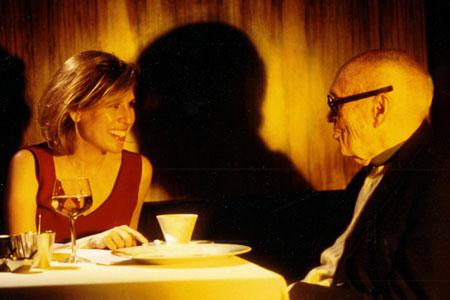
Lewis presents next Geske Lecture on Johnson
calendar icon18 Dec 2012
Architectural historian Hilary Lewis will present the next Geske Lecture titled “Philip Johnson: The Art of Architecture” on Tuesday, Feb. 5 at 7 p.m. in Sheldon Museum of Art’s Ethel S. Abbott Auditorium. The lecture is free and open to the public. A free reception will follow the lecture in the Great Hall.
Johnson designed the Sheldon Museum of Art, which celebrates its 50th anniversary in 2013.
Lewis said Johnson always saw architecture through the lens of art.
“Unlike many of his contemporaries, he was a formalist who considered projects from a visual and even cinematic perspective rather than a functionalist one,” Lewis said. “This puts Johnson more in line with pre-modern architecture.”
Yet, Lewis said, he was one of the great proselytizers for Modern architecture in America, performing extensive research on the early modern movement in Europe in the 1920s and co-curating the seminal show (and book), The International Style, at New York's Museum of Modern Art (MoMA) in 1932. He would even serve as both a client and associate of modernist master Ludwig Mies van der Rohe.
A man who never shied away from contradictions, Johnson has been hard to pin down by critics and historians. His complex and sophisticated approach to the practice of architecture can be seen as an extension of his early life as a curator and historian. At age 24, he served as MoMA's first curator of architecture and design. A decade later he would enter architecture school, at Harvard's then-School of Architecture, where Bauhaus founder Walter Gropius led architectural study. His approach to modern architecture (along with his later work, such as the Sheldon Museum of Art), was nonetheless never free of historic influence. A favorite comment was, "You cannot not know history."
With over a decade of experience working directly with Johnson, architectural historian Hilary Lewis will shed light on how Johnson, a great collector and one of the largest contributors of works to MoMA, took architecture in directions that may seem at odds with the modern movement, but how this fit with Johnson's sense of architecture's—and modernism's—place in the history of 20th century art. A man who celebrated the likes of Alfred H. Barr, Jr., the founding director of MoMA for having "an eye" (one of Johnson's greatest compliments), Johnson considered architecture a truly visual medium—a branch of art.
2013 is the 50th anniversary of the May 16, 1963, dedication of the Sheldon Museum of Art, which was designed by Johnson. With its graceful balance, arched porticoes and slender columns, the building design is reminiscent of ancient Greek temples. The relatively small gallery spaces are designed to provide an intimate encounter with the artworks shown and to create distinction from the expansiveness presented in the Great Hall.
Lewis' Biography
Lewis has collaborated with leading figures of the building industry. With eminent architect Philip Johnson, she wrote two books, multiple articles and produced a short film during 12 years of ongoing work. Lewis recorded extensively Johnson's memoirs and ideas on architecture, making her today the premier source for information on the late architect. Johnson and Lewis co-authored pieces for magazines and exhibitions, including work for The New York Times Magazine, Details and the Venice Biennale. Following Johnson's passing in 2005, Lewis curated a major museum exhibition on the architect and served as the Philip Johnson Scholar at the National Trust for Historic Preservation's Glass House site.
Lewis has taught architectural and urban history at Harvard University and MIT, as well as real estate finance and development at Harvard's Graduate School of Design. Her other experience includes advisory work on architecture and urban design at the New York Academy of Art and research at the Lincoln Institute of Land Policy in Cambridge, Mass.
About the Geske Lectureship
The Norman and Jane Geske Lectureship in the History of the Arts was established in 1995 through the generosity of Norman and Jane Geske and features noted scholars in the history of the visual arts, music, theatre, dance, film or architecture. The lectures are intended to advance the understanding and appreciation of the arts with creative writing and thinking that reflect the importance of historical perspective of the arts.
More news from:
Hixson-Lied College of Fine and Performing Arts